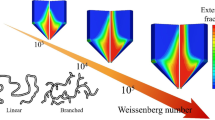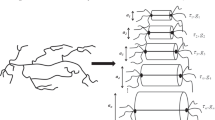Abstract
In this paper, new constitutive equations for linear entangled polymer solutions and melts are derived from a recently proposed kinetic model (Fang et al. 2004) by using five closure approximations available in the literature. The simplest closure approximation considered is that due to Peterlin (1966). In this case, a mean-field-type Fokker-Planck equation underlying the evolution equation for an equilibrium averaged polymer segment orientation tensor is shown to be consistent with the fluctuation-dissipation theorem (Kubo et al. 1985). We compare the performance of the five new constitutive equations in their capacity to faithfully reproduce the predictions of the modified encapsulated FENE dumbbell model of Fang et al. (2004) for a number of shear and extensional flows. Comparisons are also made with the experimental data of Kahvand (1995) and Bhattacharjee et al. (2002, 2003). In the case of the Hinch-Leal and Bingham closures (Hinch and Leal 1976; Chaubal and Leal 1998) a combination with the quadratic closure of Doi (1981) is found to be necessary for stability in fast flows. The Hinch-Leal closure approximation, modified in this way, is found to outperform the other closures and its mathematical description is considerably simpler than that of the Bingham closure.






Similar content being viewed by others
References
Advani SG, Tucker CL (1987) The use of tensors to describe and predict fiber orientation in short fiber composites. J Rheol 31:751–784
Bhattacharjee PK, Oberhauser JP, McKinley GH, Leal LG, Sridhar T (2002) Extensional rheometry of entangled solutions. Macromolecules 35:10131–10148
Bhattacharjee PK, Nguyen DA, McKinley GH, Sridhar T (2003) Extensional stress growth and stress relaxation in entangled polymer solutions. J Rheol 47:269–290
Bird RB, Deaguiar JR (1983) An encapsulated dumbbell model for concentrated polymer solutions and melts I. Theoretical developments and constitutive equation. J Non-Newtonian Fluid Mech 13:149–160
Bird RB, Curtiss CF, Armstrong RC, Hassager O (1987) Dynamics of Polymeric Liquids, vol. 2. Kinetic theory, 2nd edn. Wiley-Interscience, New York
Chaubal CV (1997) Ph.D. thesis, University of California, Santa Barbara
Chaubal CV, Leal LG (1998) A closure approximation for liquid-crystalline models based on parametric density estimation. J Rheol 42:177–201
Chauvière C, Lozinski L (2004) Simulation of dilute polymer solutions using a Fokker-Planck equation. Comput Fluids 33:687–696
Cintra JS, Tucker CL (1995) Orthotropic closure approximations for flow-induced fiber orientation. J Rheol 39:1095–1122
des Cloizeaux J (1988) Double reptation vs simple reptation in polymer melts. Europhys Lett 5:437–442
Doi M (1981) Molecular dynamics and rheological properties of concentrated solutions of rodlike polymers in isotropic and liquid crystalline phases. J Polym Sci, Polym Phys Ed 19:229–243
Doi M, Edwards SF (1978a) Dynamics of concentrated polymer systems: Brownian motion in the equilibrium state. J Chem Soc Faraday Trans 74:1789–1801
Doi M, Edwards SF (1978b) Dynamics of concentrated polymer systems: molecular motion under flow. J Chem Soc Faraday Trans 74:1802–1817
Doi M, Edwards SF (1978c) Dynamics of concentrated polymer systems: the constitutive equation. J Chem Soc Faraday Trans 74:1818–1832
Fang J, Kröger M, Öttinger HC (2000) A thermodynamically admissible reptation model for fast flows of entangled polymers. II. Model predictions for shear and extensional flows. J Rheol 44:1293–1317
Fang J, Lozinski A, Owens RG (2004) Towards more realistic kinetic models for concentrated solutions and melts. J Non Newtonian Fluid Mech 122:79-90
Feng J, Chaubal CV, Leal LG (1998) Closure approximations for the Doi theory: which to use in simulating complex flows of liquid-crystalline polymers? J Rheol 42:1095–1119
Grosso M, Maffettone PL, Dupret F (2000a) A closure approximation for nematic liquid crystals based on the canonical distribution subspace theory. Rheol Acta 39:301–310
Grosso M, Maffetone PL, Halin P, Keunings R, Legat V (2000b) Flow of nematic polymers in eccentric cylinder geometry: influence of closure approximations. J Non-Newtonian Fluid Mech 94:119–134
Hand GL (1962) A theory of anisotropic fluids. J Fluid Mech 13:33–46
Hinch EJ, Leal LG (1975) Constitutive equations in suspension mechanics Part 1. General formulation. J Fluid Mech 71:481–495
Hinch EJ, Leal LG (1976) Constitutive equations in suspension mechanics Part 2 Approximate forms for a suspension of rigid particles affected by Brownian rotations. J Fluid Mech 76:187–208
Hütter M, Öttinger HC (1996) Modification of linear response theory for mean-field approximations. Phys Rev E 54:2526–2530
Ianniruberto G, Marrucci G (1996) On compatibility of the Cox-Merz rule with the model of Doi and Edwards. J Non Newtonian Fluid Mech 65:241–246
Ianniruberto G, Marrucci G (2000) Convective orientational renewal in entangled polymers. J Non Newtonian Fluid Mech 95:363–374
Ianniruberto G, Marrucci G (2001) A simple constitutive equation for entangled polymers with chain stretch. J Rheol 45:1305–1318
Ianniruberto G, Marrucci G (2002) A multi-mode CCR model for entangled polymers with chain stretch. J Non Newtonian Fluid Mech 102:383–395
Kahvand H (1995) Strain coupling effects in polymer rheology. PhD Thesis, Illinois Institute of Technology
Kubo R, Toda M, Hashitsume N (1985) Statistical Physics II: Non-equilibrium Statistical Mechanics, 2nd ed. Springer, Berlin Heidelberg New York
Lielens G, Keunings R, Legat V (1999) The FENE-L and FENE-LS closure approximations to the kinetic theory of finitely extensible dumbbells. J Non Newtonian Fluid Mech 87:179–196
Lozinski A, Chauvière C (2003) A fast solver for Fokker-Planck equation applied to viscoelastic flow calculations: 2D FENE model. J Comp Phys 189:607–625
Lozinski A, Chauvière C, Fang J, Owens RG (2003) Fokker-Planck simulations of fast flows of melts and concentrated polymer solutions in complex geometries. J Rheol 47:535–561
Lozinski A, Owens RG, Fang J (2004) A Fokker-Planck-based numerical method for modelling non-homogeneous flows of dilute polymeric solutions. J Non Newtonian Fluid Mech 122:273–286
Maffettone PL (1992) A constitutive equation for monodomains of nematic polymers. J Non Newtonian Fluid Mech 45:339–354
Marrucci G (1996) Dynamics of entanglements: a nonlinear model consistent with the Cox-Merz rule. J Non Newtonian Fluid Mech 62:279–289
Marrucci G, Grizzuti N (1988) Fast flows of concentrated polymers – predictions of the tube model on chain stretching. Gazz Chim Ital 118:179–185
Marrucci G, Ianniruberto G (2003) Flow-induced orientation and stretching of entangled polymers. Phil Trans R Soc Lond A 361:677–687
Mead DW, Larson RG, Doi M (1998) A molecular theory for fast flows of entangled polymers. Macromolecules 31:7895–7914
Mead DW, Leal LG (1995) The reptation model with segmental stretch I Basic equations and general properties. Rheol Acta 34:339–359
Mead DW, Yavich D, Leal LG (1995) The reptation model with segmental stretch II. Steady flow properties. Rheol Acta 34:360–383
Öttinger HC (1994) Modified reptation model. Phys Rev E 50:4891–4895
Öttinger HC (1996) Stochastic Processes in Polymeric Fluids: Tools and Examples for Developing Simulation Algorithms. Springer, Berlin Heidelberg New York
Öttinger HC (1999) A thermodynamically admissible reptation model for fast flows of entangled polymers. J Rheol 43:1461–1493
Pearson DS, Herbolzheimer EA, Marrucci G, Grizzuti N (1991) Transient behavior of entangled polymers at high shear rates. J Polym Sci Polym Phys Ed 29:1589–1597
Peterlin A (1966) Hydrodynamics of macromolecules in a velocity field with longitudinal gradient. J Polym Sci B 4:287–291
Press WH, Flannery BP, Teukolsky SA, Vetterling WT (1989) Numerical Recipes The Art of Scientific Computing. Cambridge University Press, Cambridge
Schieber JD (1992) Do internal viscosity models satisfy the fluctuation-dissipation theorem? J Non Newtonian Fluid Mech 45:47–61
Schieber JD, Öttinger HC (1988) The effects of bead inertia on the Rouse model. J Chem Phys 89:6972–6981
Tsenoglou C (1987) Viscoelasticity of binary homopolymer blends. ACS Polym Preprints 28:185–186
van Meerveld J (2002) Private communication
Venerus DC, Kahvand H (1994) Doi-Edwards theory evaluation in double-step strain flows. J Polym Sci B Polym Phys 32:1531–1542
Zmievsky VB, Karlin IV, Deville M (2000) The universal limit in dynamics of dilute polymeric solutions. Physica A 275:152–177
Acknowledgements
The authors would like to thank Massimiliano Grosso for his help on the application of the Bingham closure and pointing out some typing errors in the paper by Grosso et al. (2000a). The authors would also like to thank Markus Hütter for useful discussions on the subject of the fluctuation-dissipation theorem. The insights provided by the referees are acknowledged with gratitude.
Author information
Authors and Affiliations
Corresponding author
Rights and permissions
About this article
Cite this article
Fang, J., Owens, R.G. New constitutive equations derived from a kinetic model for melts and concentrated solutions of linear polymers. Rheol Acta 44, 577–590 (2005). https://doi.org/10.1007/s00397-005-0440-9
Received:
Accepted:
Published:
Issue Date:
DOI: https://doi.org/10.1007/s00397-005-0440-9




